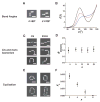Step-growth polymerization of inorganic nanoparticles
- PMID: 20616274
- PMCID: PMC4822698
- DOI: 10.1126/science.1189457
Step-growth polymerization of inorganic nanoparticles
Abstract
Self-organization of nanoparticles is an efficient strategy for producing nanostructures with complex, hierarchical architectures. The past decade has witnessed great progress in nanoparticle self-assembly, yet the quantitative prediction of the architecture of nanoparticle ensembles and of the kinetics of their formation remains a challenge. We report on the marked similarity between the self-assembly of metal nanoparticles and reaction-controlled step-growth polymerization. The nanoparticles act as multifunctional monomer units, which form reversible, noncovalent bonds at specific bond angles and organize themselves into a colloidal polymer. We show that the kinetics and statistics of step-growth polymerization enable a quantitative prediction of the architecture of linear, branched, and cyclic self-assembled nanostructures; their aggregation numbers and size distribution; and the formation of structural isomers.
Figures



References
-
- Nie Z, Petukhova A, Kumacheva E. Nat Nanotechnol. 2010;5:15. - PubMed
-
- Glotzer SC, et al. Curr Opin Colloid Interface Sci. 2005;10:287.
-
- Glotzer SC, Solomon MJ. Nat Mater. 2007;6:557. - PubMed
-
- DeVries GA, et al. Science. 2007;315:358. - PubMed
-
- Huynh WU, Dittmer JJ, Alivisatos AP. Science. 2002;295:2425. - PubMed
Publication types
MeSH terms
Substances
Grants and funding
LinkOut - more resources
Full Text Sources
Other Literature Sources
Miscellaneous

